🔎 Unknown stamps from Russia 🔎
Here are the stamps from Russia I hope you can identify, or give any suggestion.
If you have any literature or information on this please let me know it.
Even with extensive catalogues and reference works, some Russian stamps remain difficult to classify.
This page displays items with unclear origins, uncommon overprints, or unusual designs that I have not
yet been able to fully identify.
These stamps may include:
- provisional or local overprints
- revenue or fiscal issues
- trial printings or reprints
- cinderella or private productions
- postal forgeries or speculative issues
- local issues
Collectors with knowledge or expertise are welcome to share insights or suggestions. Any information
that could help confirm origin, catalog reference, or authenticity is greatly appreciated.
Until identified, these stamps remain fascinating mysteries—small pieces of postal history waiting to be
understood.

Denis Marquette (dmarquette [at] hotmail.com) added:
Actually a banknote from 1919, 3 rubles 1919 ND Exchange Notes issue, P-83a


Denis Marquette (dmarquette [at] hotmail.com) added:
Belarus 5 rubles 1921, 2nd BNR issue, BY 1921-003

Denis Marquette (dmarquette [at] hotmail.com) added:
Belarus 2 rubles 1921, 2nd BNR issue, Doctor Francysk Skaryna BY 1921-001B




Denis Marquette (dmarquette [at] hotmail.com) added:
Facit #FK1(F4) 10 Kopek Porto Stempel in Carmine. Official 1881 "Stamp Print" (meaning that it was
only printed in this size, not as a full envelope) Reprint. Large margins all around, on ungummed
white paper. VF, but a couple small black marks of unknown origin. The item of which this is a
reprint is major rarity. Despite the modest SEK 400 catalog value in Facit 2011, this is very
scarce.

Denis Marquette (dmarquette [at] hotmail.com) added:
Russia Civil War Turkestan City view stamp 25 kopek 1919 MNH A-11



Denis Marquette (dmarquette [at] hotmail.com) added:
The 3 small russian stamps are Osoaviakhim Member Fee (Union of Societies of Assistance to Defence
and Aviation-Chemical Construction of the USSR)

Denis Marquette (dmarquette [at] hotmail.com) added:
ВУИМ ВУИМ (VUIM) on a Russian stamp usually stands for Всероссийский Союз Искусств Молодежи
(Vserossiyskiy Soyuz Iskusstv Molodezhi), meaning the All-Russian Union of Youth Arts, indicating
it's a non-postal, promotional, or charity stamp/coupon from the early 20th century, often related
to cultural events or fundraising.

Denis Marquette (dmarquette [at] hotmail.com) added:
Armenia 500 Ruble 1921 Second Constantinople edition Unificato AM 123E, Michel AM IIIe; vertical
stroke
on the left of "ՌԲԼ" should extend above and below it, if not, it's a forgery.

Denis Marquette (dmarquette [at] hotmail.com) added:
ВУИМ ВУИМ (VUIM) on a Russian stamp usually stands for Всероссийский Союз Искусств Молодежи
(Vserossiyskiy Soyuz Iskusstv Molodezhi), meaning the All-Russian Union of Youth Arts, indicating
it's a non-postal, promotional, or charity stamp/coupon from the early 20th century, often related
to cultural events or fundraising.

Denis Marquette (dmarquette [at] hotmail.com) added:
Theater revenue stamps were issued on the basis of the law of the Ukrainian Hetman State of 14 June
1918.
These stamps were sold upon payment of taxes by the population.


Denis Marquette (dmarquette [at] hotmail.com) added:
100,000 rubles and 2.500 Rubles. Forged stamp by Marco Fontano from Venice. There are 6 stamps in
the
series. Never released in Russia, they were meant to trick stamp collectors.

Denis Marquette (dmarquette [at] hotmail.com) added:
100,000 rubles and 2.500 Rubles. Forged stamp by Marco Fontano from Venice. There are 6 stamps in
the
series. Never released in Russia, they were meant to trick stamp collectors.


Denis Marquette (dmarquette [at] hotmail.com) added:
This is a 50 kopek stamp commemorating the liberation of Russia, likely produced in Berlin around
1919. Cinderella stamp.

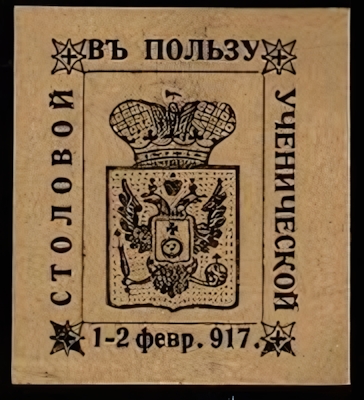
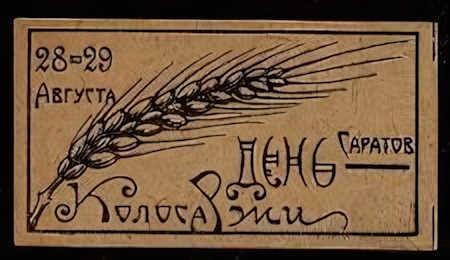

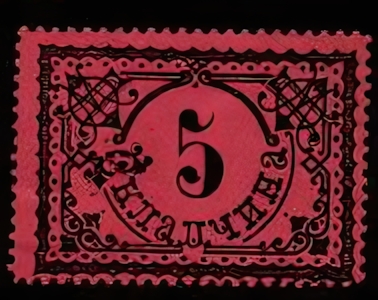
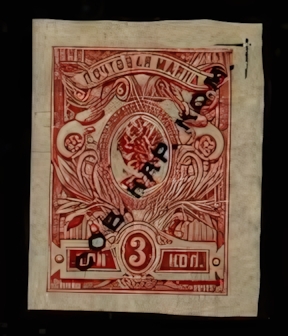
Denis Marquette (dmarquette [at] hotmail.com) added:
Overprint on 3 kopek Russian stamp, Russia Civil War, Admiral Kolchak 1919 issue.
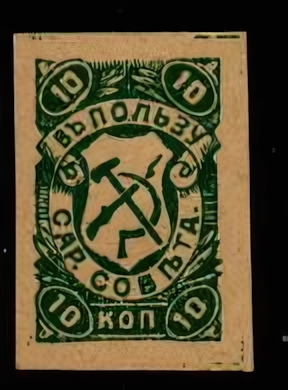
Denis Marquette (dmarquette [at] hotmail.com) added:
(green 10 kopek) is a municipal revenue stamp from Saratov, Russia.